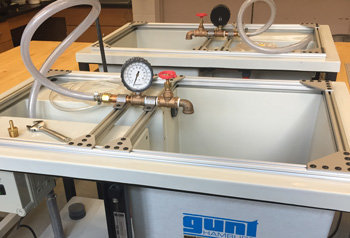A New Way to Explore Fluid Mechanics
Simple, inexpensive apparatus provides hands-on experiment in fluid mechanics course
Over the last several years, Northwestern Engineering’s Wesley Burghardt expanded the content in his CHEM_ENG 321: Fluid Mechanics course to emphasize the practical aspects about how fluid pumps work.
Wanting to offer more hands-on laboratory exercises, Burghardt leveraged the “fluids benches” in the Department of Chemical and Biological Engineering’s fluid mechanics teaching laboratory to produce a simple and inexpensive apparatus that transforms the bench into a rudimentary pump characterization experiment.
The goal of the experiment is to construct a pump performance curve by measuring the pressure head produced by the pump as a function of volumetric flow rate. Pressure is read off the gauge, while flow rate is easily measured using a bucket and stopwatch. Additional components, a threaded reducing nozzle and a plastic hose, can be added to the valve to provide additional loads to the system.
“If the valve position is left unchanged, adding one or both of these loads will shift the operating point ‘up’ the pump curve, to a lower volumetric flowrate and a higher pressure,” said Burghardt, professor of chemical and biological engineering and associate dean for undergraduate engineering at the McCormick School of Engineering. “This supports teaching other fluids topics related to analyzing piping systems, such as ‘minor losses’ associated with fittings, or ‘major losses’ associated with pipe flow.”
The apparatus design features short sections of pipe and fittings, a pressure gauge, and a globe valve. These are rigidly mounted to a frame made from extruded aluminum rail designed to fit onto the top of the benches. Water is supplied into the apparatus by the tube fed from the bench’s pump. A 90-degree elbow at the end of the apparatus directs the water leaving the test section down into the receiving ‘tub’ on the bench, from which it drains back into the reservoir.
 The COVID-19 pandemic disrupted Burghardt’s teaching patterns, requiring him to consider how this new experiment was presented to students during his Fall Quarter Fluid Mechanics course. Half of his students pursued the in-person lab experience, while the other half studied remotely. To provide all students an opportunity to use experimental data to test fluid mechanics principles, Burghardt created a series of videos illustrating the experiment and how data was collected. He then distributed that data to the students who couldn’t perform the experiments themselves.
The COVID-19 pandemic disrupted Burghardt’s teaching patterns, requiring him to consider how this new experiment was presented to students during his Fall Quarter Fluid Mechanics course. Half of his students pursued the in-person lab experience, while the other half studied remotely. To provide all students an opportunity to use experimental data to test fluid mechanics principles, Burghardt created a series of videos illustrating the experiment and how data was collected. He then distributed that data to the students who couldn’t perform the experiments themselves.
“These videos introduced each experiment so everyone could understand what the lab was about, even if they couldn’t do it,” Burghardt said. “I will continue to use these videos as a way to help students prepare for the labs when we’re back in person. Students have found access to recorded content very helpful, since they can return to it as frequently as needed.”
Burghardt is looking forward to conducting the experiment with a full class in the future.
“I am excited to have the lab, and the new experiment, available to all students,” Burghardt said. “I was blown away that half of my class elected to take on the extra work of showing up to do in-person labs last fall when it was strictly optional. This reinforces that hands-on experiences are an important part of learning fluid mechanics.”
